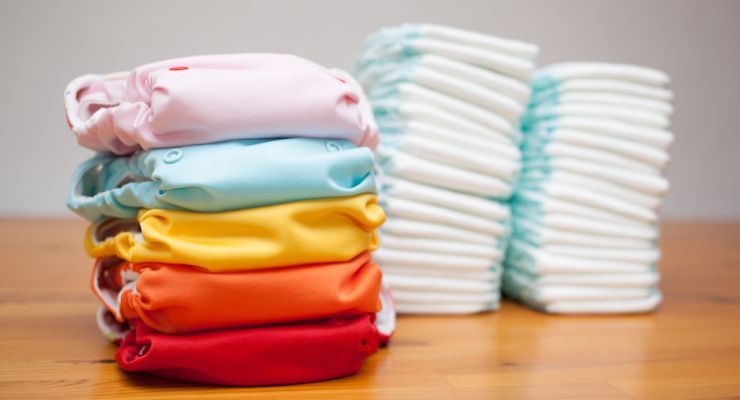With panic buying rife at the moment, many parents are finding it challenging to locate products they need to take care of their children. You’ve likely found the shelves completely empty when trying to purchase everyday items such as hand soap, toilet paper, or diapers.
Even when there are diapers left on the shelves, they may be the wrong brand (which can give your baby a rash), or there aren’t any in their size. How are busy, stressed parents supposed to make do without something as vital as diapers?
There’s no need to panic. There are, in fact, many alternatives to disposable diapers. Alternatives that could be used not only to get by for the short term but may perhaps change your approach to diapering and toilet training in general. In the list below, we will discuss diaper alternatives which just may open your eyes to the possibility of a greener, healthier, more affordable lifestyle for the future.
Easy DIY Diaper Alternatives
Rather than burning a whole tank of gas driving to check every store or combing the internet for hours looking for a deal on diapers, why not consider trying something different altogether? After all, we haven’t had the convenience of Pampers or Huggies for very long at all.
Although disposable diapers have now become an essential part of modern life, it’s interesting to remember that the first fully disposable all-in-one diaper product wasn’t available until 1961. In just a few short decades, we’ve almost completely forgotten the sustainable and natural methods used by our ancestors for millennia.
During a time when these modern “necessities” are out-of-stock in stores, people are under quarantine and unable to shop, and some people are tightening their budget amidst job losses and business closings, there is hope! After all, staying at home is a great time to consider other ideas which have a lower impact on our wallets and the planet.
An estimated 20 billion disposable diapers are added to landfills throughout the country each year, creating about 3.5 million tons of waste. Environmental agencies report that disposable diapers introduce pathogens into the environment and groundwater sources from the solid waste they contain. Plus, 30 years from now, your daughter or son (and many future generations besides) could be unknowingly taking a walk on top of their own disposed diapers in a landfill-capped community park, since they take 500 years to decompose.
So why not try one of these ideas instead?
Elimination Communication
This trending method is also known as Natural Infant Hygiene. The idea is that every baby gives a cue before they wet or soil their diaper. This could be making a certain face, noise, movement, or breathing pattern. We can watch out for their cues and hold them over a toilet, sink, or another receptacle, to try to anticipate their needs. You might be surprised at how adept you are at knowing when your little one “needs to go”, and quickly running them to the bathroom – instead of just watching them do it in their diaper. This works with any age but is especially recommended from newborn to 4 months (prior to rolling or crawling).
Purchase cloth diapers
Now could be the perfect time to try out cloth diapers. With lots of time at home to experiment with different liners, monitor your baby to prevent explosions (and do the laundry when they happen anyway), this could be your chance to become the “green parent” you’ve always aspired to be. Many cloth diaper brands have trial packs so you can try them out before investing in a larger set. Although cloth diapers are a pretty big investment upfront, they can easily save money over the 3-4 years that a child uses diapers, and even more if the set is re-used for more than one child. If they are well taken care of, good quality cloth diapers can even be sold, and the investment recouped.
Make your own cloth diapers
If you have crafty inclinations and want to save on that potentially hefty investment for ready-made cloth diapers, why not try making your own? This way, you will save money, and have control over which colors, fabrics, and details suit your preferences. Look online for ideas and patterns, and try upcycling old clothes to save on fabric costs. Hot tip: fleece fabric makes an excellent outer shell to prevent leakage, so save those old pajama pants and ski tops.
Use disposables only at night
Using cloth diapers may sound idyllic, but the reality of it can hit home when you find yourself changing sodden liners at 3 A.M. A happy medium can be to use cloth diapers during the day, but continue to use disposable ones at night. Younger babies will only need one to two changes overnight, and older babies may last until morning with just one diaper. This saves on the diaper budget big time – potentially stretching a pack to last many more days – while helping keep stress levels to a minimum with the convenient night-time disposables.
Allow naked time
Do babies even need to wear diapers at all? Having more naked time is great for babies’ skin and allows them to move freely. Especially with warmer weather on the way, why not let your younger baby relax on their playmat with a folded towel to catch any accidents. Older babies can enjoy naked time outside (or on easily cleanable floors). You may even find you’re able to naturally transition to Elimination Communication when you let your baby have more naked time, and only use diapers at night or when you leave the house.
Use makeshift diapers
If you like the sound of cloth diapers, but can’t quite front the effort or expense, and naked time sounds nice, but you’d rather not be mopping up an accident again… makeshift diapers might be the perfect option for you. This alternative involves using disposable diapers (in much smaller quantities) at night-time or when you leave the house, but when you’re at home, Little One wears essentially a ‘baby version’ of underpants, with a little more absorbency. You can easily create makeshift diapers (sometimes called sumo-style diapers) yourself with a folded rag or cloth, tucked into a waistband cut from a pair of old baby pants. This is a great way to upcycle those unused receiving blankets or swaddles. Simply launder when they become soiled. Easy, cheap, sustainable – and too cute!
Take the opportunity to potty train
If your child is at least 18 months old, why not get started on potty training a bit earlier. Potty training experts claim they could free you from diaper-changing in just one or two short weeks, so why not look around online and find some inspiration.
You may be surprised by how much you enjoy trying out an alternative to disposable diapers, and you might smile at seeing your bank balance sitting a little higher at the end of the month, too. You’ve got this!
-Susan Patterson

